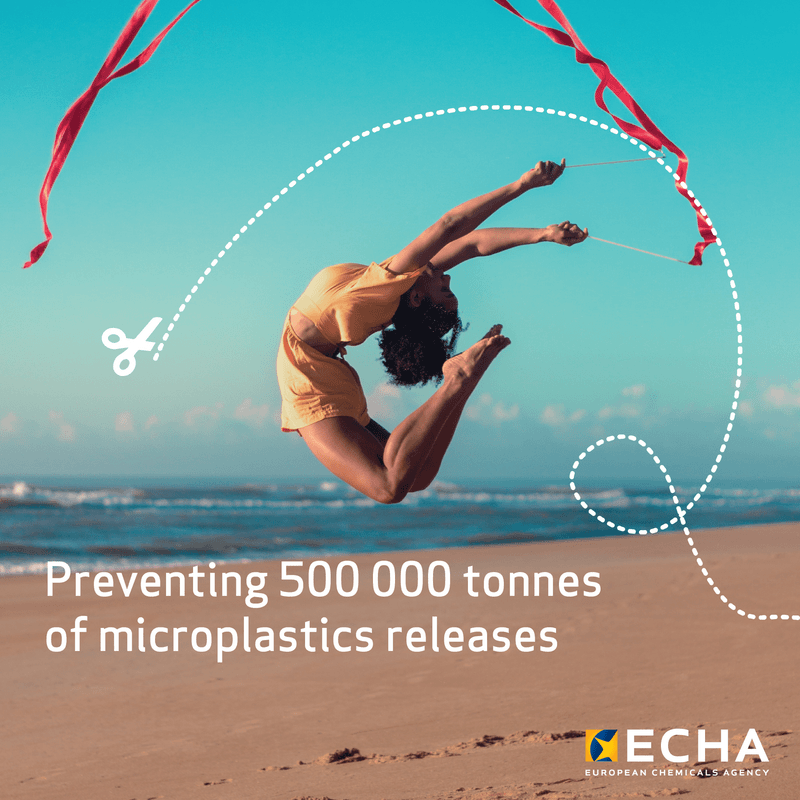Everything you always wanted to know about microplastics …

Photo: ECHA
Everything you always wanted to know about microplastics … – Plastics make our lives easier in many ways and are often lighter or cheaper than alternative materials. However, if not disposed of or recycled properly, they can end up in the environment, where they remain for centuries, breaking down into smaller and smaller pieces. These small pieces (usually smaller than 5 mm) are called microplastics and are of concern.
Microplastics are solid plastic particles made up of mixtures of polymers and functional additives. They may also contain residual impurities. Microplastics can be created unintentionally when larger plastic items, such as car tires or synthetic textiles, succumb to wear and tear. But they are also purposefully manufactured and added to products for specific purposes, such as exfoliating beads in facial or body scrubs.
What are the concerns?
Once microplastics enter the environment, they do not biodegrade. They accumulate in animals – such as fish and crustaceans – and are therefore also consumed by humans as food.
Where microplastics occur
Microplastics have been found in marine, freshwater and terrestrial ecosystems, as well as in food and drinking water. Its continued release contributes to the permanent pollution of our ecosystems and food chains. Exposure to microplastics has been linked in laboratory studies to a range of adverse (eco)toxic and physical effects on living organisms.
Proposed bans
In response to environmental and health concerns, several EU member states have already adopted or proposed national bans on the intentional use of microplastics in consumer products. The bans primarily address the use of microspheres in cosmetics that are rinsed off after use, where the microplastic is used as an abrasive and polishing agent.
The sources
Each year, about 42,000 tons of microplastics enter the environment when products containing them are used. The largest source of pollutants is the granular infill material used on artificial turf fields, with emissions of up to 16,000 tons. In addition, emissions of unintentionally formed microplastics (when larger pieces of plastic are worn off) in European surface waters are estimated at about 176,000 tons per year.
Microplastics in food
In 2016, the European Food Safety Authority (EFSA) reviewed the available evidence on microplastics and nanoplastics in food. Experts identified the need to collect more data on their presence in food and their potential impact on human health. To this end, EFSA is organizing a scientific colloquium in 2021 to discuss the current state of play and ongoing research in this area.
Which products contain intentionally added microplastics?
Microplastics are deliberately added to a range of products, including fertilizers, pesticides, cosmetics, household and industrial detergents, cleaning products, paints and products used in the oil and gas industry. Microplastics are also used as a soft infill material on artificial turf sports fields.
The function of microplastics
In consumer products, microplastic particles are best known as abrasives (for example, as exfoliants and polishes in cosmetics, also known as microbeads), but they can also have other functions, such as controlling the thickness, appearance and stability of a product. They are even used as glitter or in makeup.
Total use of microplastics
Overall, it is estimated that approximately 145,000 tons of microplastics are used in the EU/EEA each year.
Proposed bans
In response to environmental and health concerns, several EU member states have already adopted or proposed national bans on the intentional use of microplastics in consumer products. The bans primarily address the use of microspheres in cosmetics that are rinsed off after use, where the microplastic is used as an abrasive and polishing agent.
The sources
Each year, about 42,000 tons of microplastics enter the environment when products containing them are used. The largest source of pollutants is the granular infill material used on artificial turf fields, with emissions of up to 16,000 tons. In addition, emissions of unintentionally formed microplastics (when larger pieces of plastic are worn off) in European surface waters are estimated at about 176,000 tons per year.
Microplastics in food
In 2016, the European Food Safety Authority (EFSA) reviewed the available evidence on microplastics and nanoplastics in food. Experts identified the need to collect more data on their presence in food and their potential impact on human health. To this end, EFSA is organizing a scientific colloquium in 2021 to discuss the current state of play and ongoing research in this area.
Which products contain intentionally added microplastics?
Microplastics are deliberately added to a range of products, including fertilizers, pesticides, cosmetics, household and industrial detergents, cleaning products, paints and products used in the oil and gas industry. Microplastics are also used as a soft infill material on artificial turf sports fields.
The function of microplastics
In consumer products, microplastic particles are best known as abrasives (for example, as exfoliants and polishes in cosmetics, also known as microbeads), but they can also have other functions, such as controlling the thickness, appearance and stability of a product. They are even used as glitter or in makeup.
Total use of microplastics
Overall, it is estimated that approximately 145,000 tons of microplastics are used in the EU/EEA each year.
Timetable for reducing intentionally added microplastics
| Timing | |
|---|---|
| Intent to create a restriction file | 17 January 2018 |
| Call for evidence | 1 March - 1 May 2018 |
| Stakeholder workshop | 30 - 31 May 2018 |
| Submission of Annex XV restriction file | 11 January 2019 |
| Consultation on the Annex XV file | 20 March 2019 - 20 september 2019 |
| RAC advice | June 2020 |
| Draft SEAC Opinion | June 2020 |
| Consultation on draft SEAC opinion | 1 july 2020 - 1 september 2020 |
| Joint final opinion sent to the Commission | February 2021 |
| Commission draft amendment to Annex XVII (draft restriction) | 30 augustus 2022 |
| Discussions with Member State authorities and coordination | 2022 - 2023, voted on 27 April 2023 |
| Control by the Council and the European Parliament | Before adaption (three months) |
| Restriction adopted | 25 September 2023 |
- RAC advice – June 2020
- Joint final opinion sent to the Commission – February 2020
- Commission draft amendment to Annex XVII (draft restriction) – 30 August 2022
Related
General information
Statements and answers
- Response to Ms. Anja Stahmann, Senator for Social Affairs, Youth, Women, Integration and Sports [PDF] [DE]
- Response to various soccer associations [PDF] the and
- Response from the Chair of ECHA’s Management Board to NGOs’ concerns about the call for evidence on intentionally added microplastics [PDF].
European Commission
- Restriction in the Official Journal, September 27, 2023.
- Public consultation on unintentionally released microplastics, February 22 – May 17, 2022.
- Plastic waste: a European strategy to protect the planet, defend our citizens and strengthen our industries – Jan. 16, 2018
- European Commission Plastics Strategy
- Intentionally added microplastics in products – final report of the study carried out by Amec Foster Wheeler Environment & Infrastructure UK Limited for the European Commission in October 2017.
- Report for the European Commission: exploring options to reduce emissions to the aquatic environment of microplastics emitted from (but not intentionally added to) products.
- A Scientific Perspective on Microplastics in Nature and Society (SAPEA).
Other links
- EFSA Scientific Colloquium “A coordinated approach to assessing human health risks from micro- and nanoplastics in food”, 6-7 May 2021, Lisbon.
- Occurrence of microplastics and nanoplastics in food, with a particular focus on seafood – scientific advice to EFSA’s Panel on Contaminants in the Food Chain (CONTAM).
- European Parliament – Strategy for Plastics in the Circular Economy / 2017 (below: Legislative Train Plan).
Source: ECHA
Also Read: More than 5600 responses to ECHA’s PFAS restriction proposal
Reservation
This information has been compiled with the greatest possible care, in some cases from different information sources. (Interpretation) errors are not excluded. No legal obligation can therefore be derived from this text. Everyone dealing with this subject has the responsibility to delve into the matter!

Trackbacks/Pingbacks